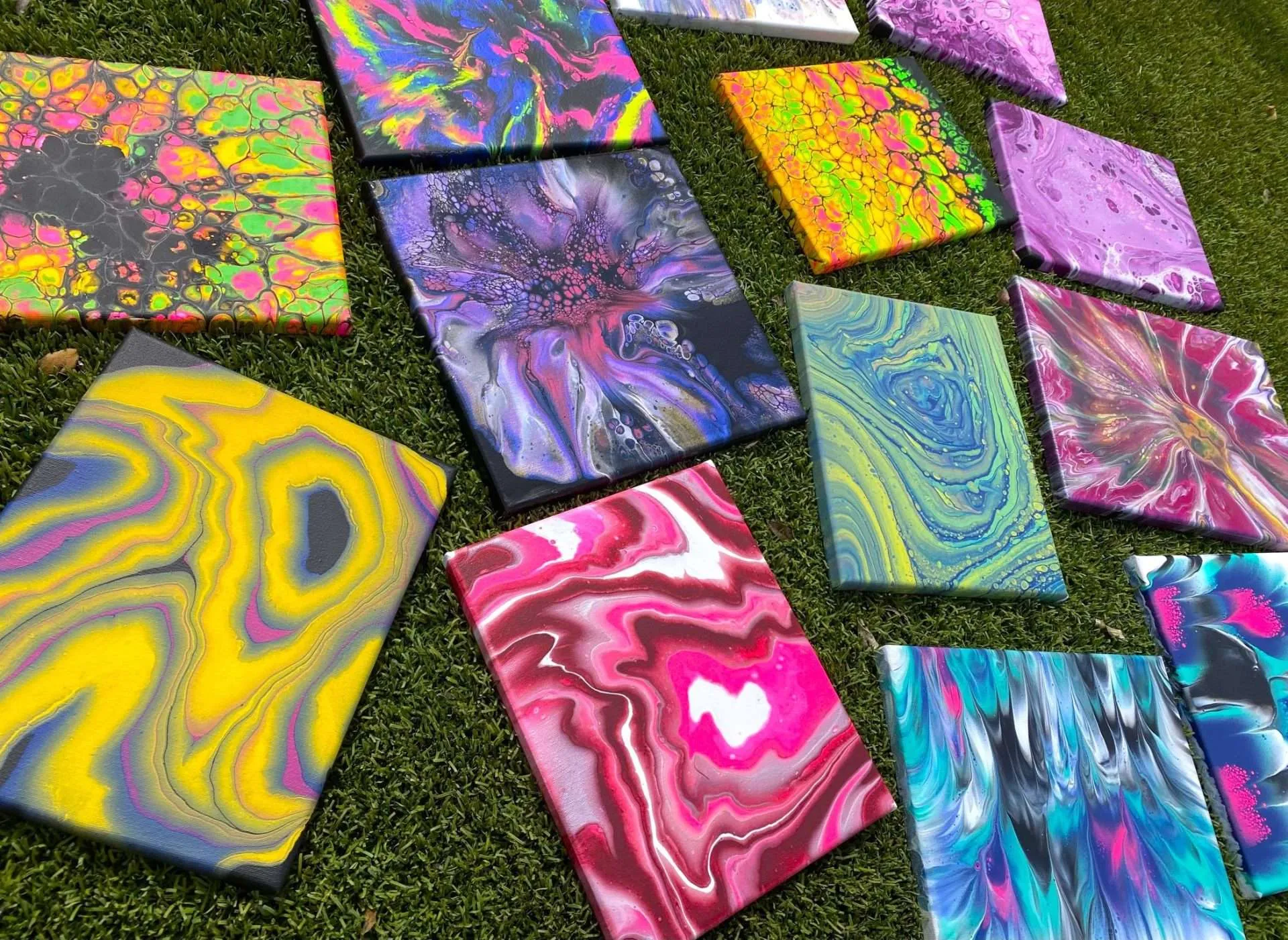Paint pouring has surged in popularity as one of the most captivating forms of fluid art. With its mesmerizing flow, unpredictable patterns, and endless color combinations, it allows artists of all skill levels to create stunning abstract works with ease. In this comprehensive guide, we delve into the materials, techniques, surface preparation, and finishing touches necessary to master the art of paint pouring. Whether you’re a beginner or looking to refine your fluid art, this guide will help elevate your skills and creative output.
What is Paint Pouring?
Paint pouring, also known as acrylic pouring or fluid acrylic art, is a technique where acrylic paints are mixed with a pouring medium to create a flowable consistency. Artists pour this mixture onto a canvas or other surface, allowing it to spread, swirl, and interact in visually striking ways. The goal is to manipulate the paints without the use of brushes, embracing spontaneity and organic forms.
Essential Supplies for Paint Pouring
To achieve professional results, using the right materials is critical. Below are the core components required:
Acrylic Paint
Use high-quality or student-grade acrylics.
Opt for high-pigment paints for vibrant results.
Pre-mixed pouring paints are available but costlier.
Pouring Medium
This is what gives the paint the correct viscosity and allows for smooth, even flow.
Liquitex Pouring Medium: Excellent for gloss and color retention.
Floetrol: A more affordable option, widely used by DIY artists.
Canvas or Surface
Stretched canvas
Wood panels
Tiles or glass
MDF boards
Ensure the surface is clean, level, and primed.
Cups and Stir Sticks
Use disposable or reusable plastic cups.
Wooden or silicone stir sticks help with even mixing.
Protective Gear
Gloves
Aprons
Drop cloths or plastic sheeting to protect surfaces
Torch or Heat Gun
Used to eliminate air bubbles and enhance cell formation in the paint.
Popular Paint Pouring Techniques
Dirty Pour
All paint colors are layered in one cup and poured simultaneously. This technique produces marbled and swirled effects.
Flip Cup
A variation of the dirty pour where the cup is flipped onto the canvas before being lifted. It often creates dramatic central bursts of color.
Puddle Pour
Each color is poured individually in concentric circles or overlapping puddles. This allows for controlled blending and layering.
Swipe Technique
After pouring, a swipe tool (paper towel or palette knife) is used to drag paint across the canvas, revealing underlying colors and cells.
Dutch Pour
Utilizes a hairdryer or airbrush to blow paint outward from the center, creating feathered and floral effects.
String Pull
Paint is drizzled over a string or chain, then pulled across the canvas to produce petal or wave-like formations.
Mixing the Perfect Paint Pouring Consistency
Achieving the right paint consistency is critical for successful pours. Follow this general ratio:
1 part acrylic paint
2 parts pouring medium
Add water gradually until you reach the texture of warm honey
Tips for consistency:
Stir slowly to reduce bubbles.
Perform a “drip test” from your stick—paint should flow continuously, not plop.
Creating Cells in Your Paint Pours
Cells are beautiful, round formations in poured paint that resemble organic structures. To encourage cell formation:
Add a few drops of silicone oil to your paint mix.
Use a torch or heat gun to draw cells to the surface.
Swiping or tilting techniques can help enhance or stretch cells.
Popular silicone oils:
Treadmill belt lubricant
Dimethicone-based hair serums
Surface Preparation and Pre-Pour Checklist
Before you pour, take these critical steps:
Level Your Surface: Uneven surfaces lead to paint running off.
Prime Your Canvas: Use white gesso to ensure better adhesion.
Set Up a Drip Tray: Prevent mess by elevating your canvas and catching runoff.
Prepare Enough Paint: Always mix more paint than you think you’ll need.
These precautions help ensure clean results and reduce frustration during the pouring process.
Drying and Curing Your Paint Pour Art
Drying time: 24 to 72 hours, depending on humidity and paint thickness.
Curing time: Wait up to 3 weeks before sealing.
Tips for drying:
Keep the canvas in a dust-free zone.
Avoid moving it during the first 24 hours.
Sealing and Finishing Your Paint Pour Artwork
Once fully cured, sealing your artwork will protect it and enhance its appearance.
Sealant Options:
Resin: Provides a glass-like, professional finish.
Polyurethane spray: Easy to apply, available in matte or gloss.
Varnish: Use acrylic varnish for durable protection.
Resin Application Tips:
Mix precisely according to instructions.
Use a torch to pop bubbles after pouring.
Work in a dust-free, well-ventilated area.
Troubleshooting Common Paint Pouring Issues
Cracking
Cause: Paint is too thick or dried too quickly.
Solution: Adjust your paint-to-medium ratio and control drying environment.
Muddy Colors
Cause: Overmixing or incompatible color layering.
Solution: Limit color blending and use a color wheel to plan your palette.
Air Bubbles
Cause: Vigorous stirring or pouring too fast.
Solution: Stir slowly and use a torch post-pour.
Uneven Drying
Cause: Unlevel surface or inconsistent paint application.
Solution: Double-check your level before pouring and rotate canvas during drying if needed.
Creative Ideas and Variations for Paint Pouring
Geode-Inspired Pours
Incorporate glitter, crushed glass, and metallics to mimic gemstones and crystal formations.
Galaxy Pours
Use deep blues, purples, black, and white splatters to replicate cosmic scenes.
Split Canvas Designs
Pour across two or more canvases for a diptych or triptych layout—perfect for home decor.
Negative Space Technique
Leave parts of the canvas unpainted or minimal for a modern, minimalist aesthetic.
Conclusion: Express Yourself with Fluid Art Mastery
Paint pouring invites us to embrace spontaneity, color theory, and emotion through movement. Each pour is a one-of-a-kind masterpiece shaped by the laws of physics and the vision of the artist. With the right tools, patience, and passion, anyone can create vibrant, gallery-worthy works that reflect their personal style.



















